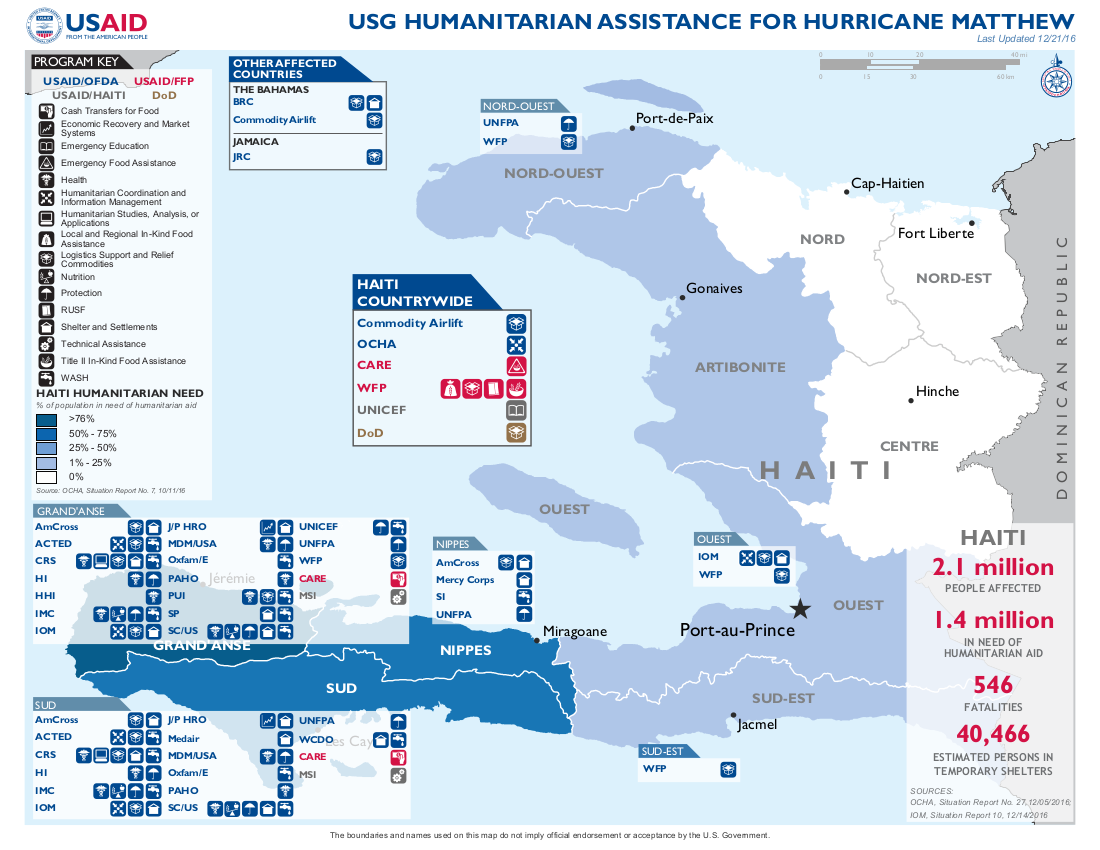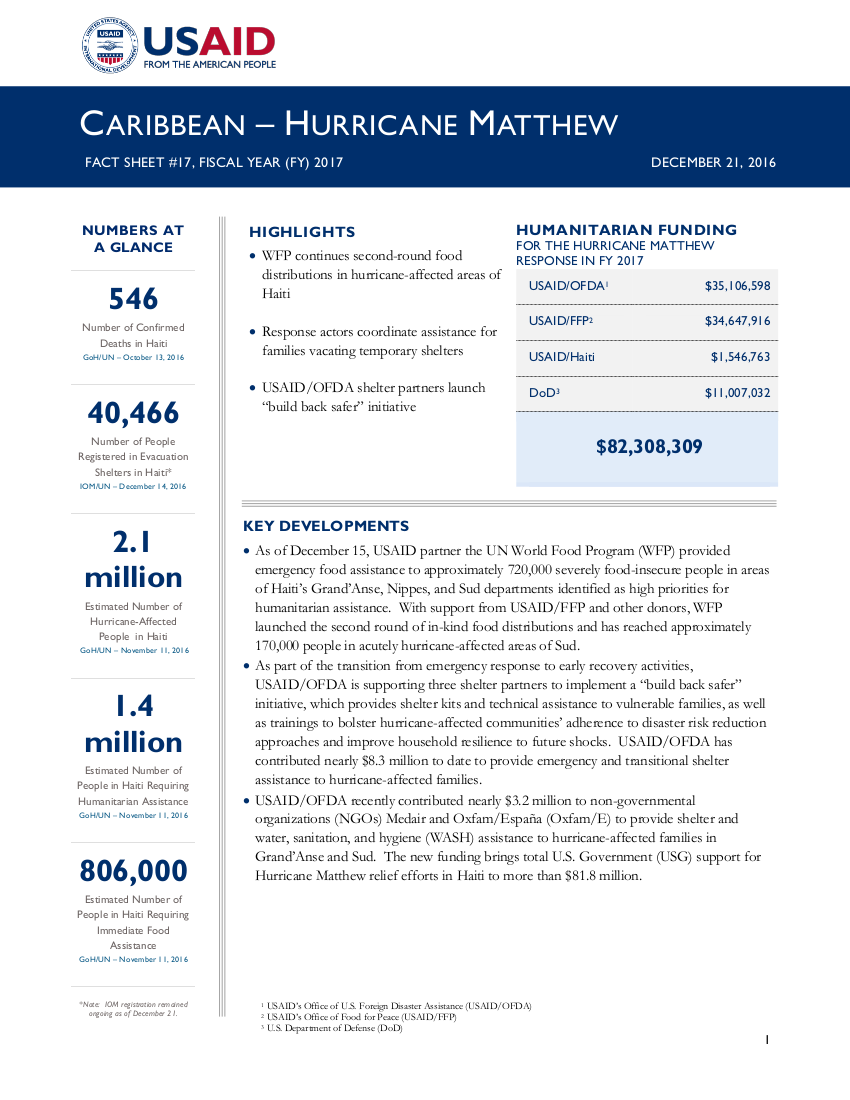December 21, 2016
Highlights
WFP continues second-round food distributions in hurricane-affected areas of Haiti
Response actors coordinate assistance for families vacating temporary shelters
USAID/OFDA shelter partners launch “build back safer” initiative
Key Developments
As of December 15, USAID partner the UN World Food Program (WFP) provided emergency food assistance to approximately 720,000 severely food-insecure people in areas of Haiti’s Grand’Anse, Nippes, and Sud departments identified as high priorities for humanitarian assistance. With support from USAID/FFP and other donors, WFP launched the second round of in-kind food distributions and has reached approximately 170,000 people in acutely hurricane-affected areas of Sud.
Numbers At A Glance
546
40,466
2.1 million
1.4 million
806,000
Humanitarian Funding
For the Hurricane Matthew Response
in FY 2017
| USAID/OFDA | $35,106,598 |
| USAID/FFP | $34,647,916 |
| USAID/Haiti | $1,546,763 |
| DoD | $11,007,032 |
| TOTAL | $82,308,309 |
As part of the transition from emergency response to early recovery activities, USAID/OFDA is supporting three shelter partners to implement a “build back safer” initiative, which provides shelter kits and technical assistance to vulnerable families, as well as trainings to bolster hurricane-affected communities’ adherence to disaster risk reduction approaches and improve household resilience to future shocks. USAID/OFDA has contributed nearly $8.3 million to date to provide emergency and transitional shelter assistance to hurricane-affected families.
USAID/OFDA recently contributed nearly $3.2 million to non-governmental organizations (NGOs) Medair and Oxfam/España (Oxfam/E) to provide shelter and water, sanitation, and hygiene (WASH) assistance to hurricane-affected families in Grand’Anse and Sud. The new funding brings total U.S. Government (USG) support for Hurricane Matthew relief efforts in Haiti to more than $81.8 million.
EMERGENCY FOOD ASSISTANCE AND LIVELIHOODS
As of December 15, WFP and implementing organizations had completed first-round emergency food distributions for approximately 720,000 severely food-insecure people in areas of Grand’Anse, Nippes, and Sud identified as high priorities for humanitarian assistance. To date, WFP and partners have reached approximately 170,000 people with second-round food distributions; in addition, WFP has provided supplementary food assistance to an estimated 12,500 children ages 6–59 months and 850 pregnant and lactating women.
USAID/FFP has contributed more than $34.6 million—including more than $19.2 million to WFP and $15.4 million to NGO partner CARE—to meet hurricane-affected families’ urgent food needs. Through a CARE-led NGO consortium, USAID/FFP is providing cash-based assistance to approximately 500,000 people in Grand’Anse and Sud. After an initial distribution of unconditional cash assistance, the consortium plans to transition to cash-for-work activities that will assist approximately 98,000 beneficiaries, building the foundation for livelihood recovery by increasing vulnerable households’ access to food, while restoring community assets damaged by the hurricane.
The UN Development Program (UNDP) had supported the creation of an estimated 123,680 jobs—including clearing irrigation canals and roads, as well as collecting debris and waste—for hurricane-affected individuals through cash-for-work programs as of December 19. As part of these interventions, USAID/OFDA is supporting J/P Haitian Relief Organization (J/P HRO) to conduct debris clearing, road repairs, and other activities. From December 13–16, J/P HRO employed hurricane-affected people to clear and repair approximately 22 miles of roads and create more than 14 miles of new access roads in Sud, increasing access to affected communities.
NUTRITION AND WASH
According to the UN Children’s Fund (UNICEF), there is an increased likelihood that up to 11,100 children younger than five years of age will experience acute malnutrition during the first half of 2017. Recent nutrition screenings in eight communes of Sud and three communes of Grand’Anse identified localized pockets of acute malnutrition, although these elevated levels may reflect hurricane-affected communities’ increased access to health care and nutrition screenings, rather than a significant deterioration in nutrition conditions following the hurricane. To date, UNICEF and its implementing partners have restored more than 40 outpatient therapeutic feeding centers and four inpatient centers to provide acute malnutrition treatment in Grand’Anse and Sud.
To prevent and treat acute malnutrition, USAID/OFDA is supporting NGO partners to implement infant and young child feeding in emergencies programs, including the promotion of exclusive breast feeding and complementary feeding initiatives, as well as to conduct malnutrition screenings and referrals to health care facilities as needed. The USAID Disaster Assistance Response Team (DART) in Haiti, in coordination with health partners, continues to monitor the nutrition situation in affected areas.
USAID/OFDA recently committed $870,500 to Oxfam/E to provide WASH support to hurricane-affected families in Grand’Anse and Sud. With USAID/OFDA assistance, Oxfam/E is conducting hygiene promotion campaigns, distributing hygiene kits, and facilitating access to safe drinking water for approximately 35,000 people in the two departments. To date, USAID/OFDA has provided nearly $5 million for WASH interventions—including promoting safe hygiene practices, rehabilitating damaged sanitation facilities, and installing water treatment systems to increase access to safe drinking water—in hurricane-affected areas.
SHELTER AND SETTLEMENTS
Displaced households continue to vacate temporary shelters and return to their areas of origin or other host communities. The humanitarian community and the DART are encouraging response partners to prioritize shelter repairs for the most vulnerable households to facilitate safe and voluntary returns. USAID/OFDA partner the International Organization for Migration (IOM) continues to conduct registrations at displacement sites in hurricane-affected areas; IOM had registered approximately 9,440 displaced households—nearly 40,470 individuals—at an estimated 360 sites in Grand’Anse, Sud, and Nippes as of December 14.
USAID/OFDA recently provided $2 million in additional funding to NGO partner Medair for the provision of transitional shelter assistance in Sud’s Aquin and Tiburon communes. With the additional funding, Medair will implement USAID/OFDA’s “build back safer” initiative, which supports the most vulnerable hurricane-affected households through the distribution of shelter kits and training on the use of shelter materials and raises community awareness on disaster-resilient shelter recovery and reconstruction techniques to build resilience to future shocks. USAID/OFDA is also supporting partners Catholic Relief Services (CRS) and J/P HRO to conduct “build back safer” activities to mitigate the risk of future natural hazards in Grand’Anse and Sud.
EDUCATION
Approximately 60 percent of private schools in hurricane-affected areas had reopened as of mid-December, UNICEF reports. To date, the UN agency has supported the resumption of classes at more than 50 schools in Grand’Anse. UNICEF aims to provide rehabilitation support and other assistance at more than 650 schools; Government of Haiti (GoH) verification of the schools slated for rehabilitaiton remained pending as of December 15.
USAID/Haiti is supporting UNICEF with nearly $1.5 million to enable the restoration of educational capacity in Grand’Anse, Nippes, and Sud, including through the rehabilitation of 50 schools across the three departments, the distribution of 45,000 kits for school-aged children and 1,000 kits for teachers, and the provision of instructional materials, school bags, and school furniture.
PROTECTION
On December 6, IOM launched a hotline—managed by 10 IOM-trained staff—to register and provide support for suspected human trafficking cases. The hotline had received nearly 1,300 calls as of December 14. IOM continues to co-lead a sub-working group on human trafficking, which aims to ensure the integration of counter-trafficking activities into response efforts in hurricane-affected areas.
Protection actors have established psychosocial support activities in Sud’s Camp Perrin, Chantal, Torbeck, and Roche-a-Bateaux communes, UNICEF reports. In addition, a UNICEF implementing partner has provided psychosocial support to approximately 600 hurricane-affected families in Grand’Anse as part of the registration process for households in temporary shelters.
USAID/OFDA is supporting UNICEF and implementing partner the Initiative Départementale contre la Traite et le Traffic des Enfants (IDETTE) to operate 13 child-friendly spaces and child protection committees in Grand’Anse, including 10 spaces in Jeremie commune, two in Chambellan commune, and one in Roseaux commune. Through the child-friendly spaces and child protection committees, IDETTE supports children requiring specialized attention, including cases where children have been abandoned, neglected, or separated from their families or are considered at increased risk of trafficking following the hurricane. USAID/OFDA has provided nearly $1 million to date for protection interventions in hurricane-affected areas, including the provision of psychosocial support and the establishment of child-friendly spaces and safe spaces for women and girls, among other activities.
OTHER HUMANITARIAN ASSISTANCE
In late November, the UN Office for the Coordination of Humanitarian Affairs (OCHA) released a revised flash appeal to reflect both delivered humanitarian assistance and the outstanding critical needs of hurricane-affected people in Haiti. The revised appeal requests $139 million—an increase of approximately $19 million from the initial appeal, launched in October—and seeks to provide emergency food assistance to 806,000 people; emergency relief commodities to 805,000 people; and health and WASH assistance to 750,000 people, among other interventions. As of December 20, international donors had contributed nearly $79.6 million—approximately 57 percent of the requested total—toward the revised flash appeal, according to OCHA.
CONTEXT
Hurricane Matthew made initial landfall near Les Anglais, Haiti, and secondary landfall over eastern Cuba on October 4 before continuing to traverse The Bahamas from October 5–7. The hurricane brought destructive winds, heavy rainfall, and dangerous storm surge, resulting in extensive damage to crops, houses, and infrastructure, as well as widespread flooding in some areas.
On October 2, U.S. Ambassador to Haiti Peter F. Mulrean and U.S. Chargé d’Affaires, a.i., for Jamaica Eric Khant issued disaster declarations in response to the anticipated effects of Hurricane Matthew. U.S. Chargé d’Affaires, a.i., Lisa A. Johnson issued a disaster declaration in response to the anticipated effects of Hurricane Matthew in The Bahamas on October 4.
USAID activated a regional DART on October 3 with staff in The Bahamas, Haiti, and Jamaica. USAID also stood up a Washington, D.C.-based Response Management Team to coordinate the regional humanitarian response.
Based on assessment findings and in consultation with government representatives in the two countries, USAID discontinued DART operations in Jamaica and The Bahamas on October 5 and 13, respectively. USAID/OFDA regional staff will continue to monitor USAID/OFDA assistance provided to the Bahamas Red Cross (BRC) and the Jamaica Red Cross (JRC) to address the immediate needs of populations affected by Hurricane Matthew.









Comment
Make a general inquiry or suggest an improvement.